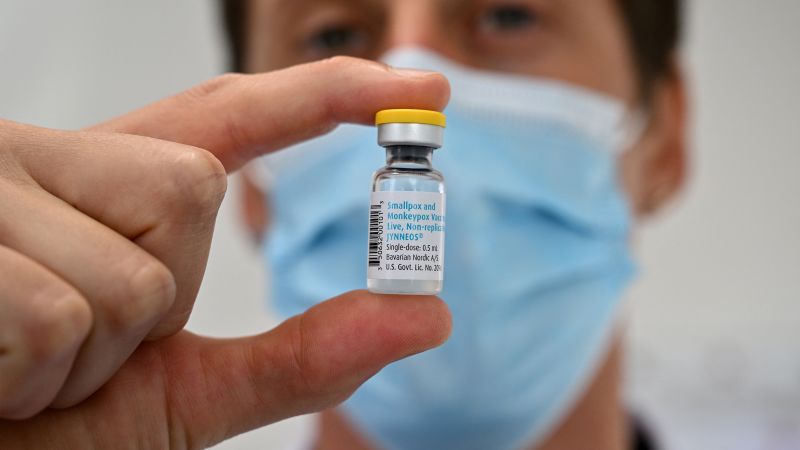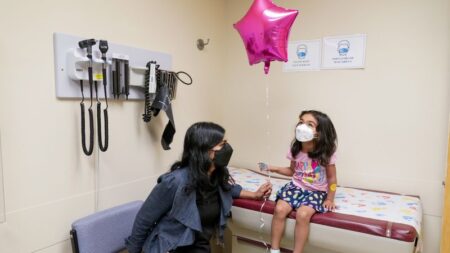As the mpox outbreak continues to escalate in Africa and other regions, health officials in the United States are deliberating whether vulnerable populations may require booster doses of the mpox vaccine.
In a significant development last month, the World Health Organization classified an outbreak in the Democratic Republic of Congo as a public health emergency of international concern, prompting alarms as the outbreak spreads to an increasing number of countries in Africa.
Mpox, previously referred to as monkeypox, is divided into two genetic clades, I and II. The current concern revolves around clade Ib, a newer subtype that has been linked to more severe cases of the disease.
The 2022 global outbreak was primarily linked to clade IIb, spreading predominantly through sexual contact and resulting in over 30,000 infections in the United States. This outbreak was also labeled a public health emergency of international concern. Vaccination efforts utilizing the Jynneos mpox vaccine significantly mitigated the transmission rate, almost eradicating the virus in the U.S.
The Jynneos vaccine, designed for protection against both mpox and smallpox, is administered in two doses four weeks apart. As new infections arise, public health experts are weighing the necessity of booster shots to sustain immunity levels, amid concerns that vaccine efficacy may decline over time.
Dr. Ashish Jha, dean of the Brown School of Public Health and former White House Covid-19 response coordinator, commented, “I’ve literally had people call me and say, ‘Should I get a booster, because it’s been two years?’ and my suggestion right now is, I don’t see an obvious reason for a booster.” He also emphasized that if clade Ib starts to circulate rapidly in the U.S., with breakthrough infections in vaccinated individuals, a booster campaign would be advisable. However, he asserted, “I just don’t think we have enough data right now to recommend boosters for everybody who got previously vaccinated.”
Local health departments in the U.S. have not reported significant mpox cases this year, according to Lori Tremmel Freeman, CEO of the National Association of County and City Health Officials. She added, “But we’re remaining diligent in the face of the global outbreaks and constantly in the preparedness stance.”
The U.S. Centers for Disease Control and Prevention (CDC) currently assesses the overall risk of mpox to be low. CDC spokesperson David Daigle remarked, “Casual contact in travel settings, for example, as a passenger in an airplane, is unlikely to pose significant risks for transmission.” He also clarified that the CDC does not recommend administering more than two doses of the Jynneos vaccine to the general public and will continuously monitor vaccination data.
In an email, Daigle stated, “Two doses of JYNNEOS vaccine may prevent mpox and can reduce the severity of symptoms in infected persons,” adding that breakthrough infections after the two doses have been rare in prior outbreaks. Many health officials underscore the current priority is ensuring that high-risk individuals complete their initial vaccination series.
The CDC encourages vaccination for individuals exposed to the virus, men who have sex with men, and those attending sexual events. Dr. Justin Chan, director of infection prevention at NYC Health + Hospitals/Bellevue, noted, “More than two vaccine doses are not recommended unless you are a lab worker who works with live mpox and other related viruses in a research lab.”
Chan also reassured that CDC projections indicate a minimal risk of significant spread should clade I cases appear in the U.S., thanks to high immunity levels among at-risk groups. Data suggests that a two-dose regimen of Jynneos has an effectiveness ranging from 66% to 89%, according to CDC figures.
David C. Harvey, executive director of the National Coalition of STD Directors, remarked, “There still are some open research questions, including potentially in the future some need for boosters. But that’s not the focus now; the focus now is on getting people vaccinated and getting them access to the vaccine.”
However, statistics reveal only about 25% of the most at-risk U.S. population has been fully vaccinated. Harvey criticized the current vaccination rates, stating, “Vaccine rates in the US are unacceptably low, and it’s even lower for people coming back and completing the two doses of vaccine.” He urged that “the urgent priority now has to be for gay men and bisexual men and other people at risk to get the vaccine now.”
A recent study raised concerns that immunity from Jynneos could diminish within a year post-vaccination, prompting discussions about the potential need for booster doses to maintain adequate protective immunity.
While the study, which analyzed data from 45 adults vaccinated or infected during the 2022 outbreak, has not yet been peer-reviewed, it suggested that vaccine-induced antibodies peaked around three weeks after two doses and declined significantly within a year.
Dr. Dan Barouch, lead author of the study, conveyed, “Our data shows that the antibody responses induced by the mpox vaccine are moderate to high titer after the two-dose vaccine.” He noted that antibody levels dropped significantly by the one-year mark.
The same decline in immunity was observed among individuals receiving only one dose. Participants with natural immunity from prior mpox infections retained high levels of antibodies for nine months post-infection.
The findings from this study echo two other recent publications indicating that immune responses to the mpox virus may decrease within a year post-vaccination. Barouch noted a previous cluster of mpox cases in Chicago where fully vaccinated individuals contracted the virus, further highlighting concerns over waning immunity.
Regarding the implications of these findings, Dr. Jha stated, “A drop in antibody levels makes me believe that you probably do have people who may be susceptible to infection again.” However, he reassured that vaccinated individuals who do contract the virus are likely to respond more robustly and clear the infection faster, leading to less severe illness.
“There’s still much we do not know about what these markers of immunity signify,” commented Jeffrey Crowley of Georgetown University Law Center. He added, “In the future, maybe they’ll say we need a booster dose, but I don’t think we’re there yet.”
Bavarian Nordic, the manufacturer of Jynneos, acknowledged that the last significant outbreak occurred two years ago and is in ongoing discussions with research groups about the duration of immunity. The company recently announced the arrival of Jynneos doses in the Democratic Republic of Congo, with over 250,000 doses already shipped and further commitments for over 500,000 doses from various countries.
Productions are being ramped up, with the capacity to supply up to 13 million doses by the end of 2025, including 2 million in 2024.
Experts remain uncertain about the outbreak’s implications globally, but Barouch suggested that emerging data on waning immunity could be vital for U.S. response efforts. “Obviously, we’re not isolated from the rest of the world, so it’s only a matter of time before it comes here,” he stated.
As of now, there are no known cases of clade Ib strain in the U.S., but Jha expresses confidence that its arrival is inevitable. “We’re a pretty globalized country. We have lots of people who travel,” he stated, indicating an expectation for cases to surface.
The CDC is actively monitoring the situation, having distributed over 1 million vials of Jynneos vaccine since August 2022. However, these vaccines have migrated to the commercial market, prompting concerns over potential costs for those without access to free vaccines through government programs or insurance, with prices nearing $300.
The U.S. Health Resources and Services Administration (HRSA) recently announced the renewed availability of the Jynneos vaccine from the Strategic National Stockpile, which has limited doses expiring on October 31.
The letter revealed that free vaccines remain accessible through specific health organizations and community health centers, reinforcing efforts to bolster vaccinations among high-risk populations.
Despite the current low circulation of mpox in the U.S., Harvey voiced concerns regarding the future risks posed by the clade Ib strain, asserting, “Let’s not fool ourselves. This is highly likely to emerge in the US. To what extent it will emerge, we do not know.”
He also warned that the U.S. is “not ready” for a potential mpox outbreak due to a shortage of disease intervention specialists who play essential roles in managing infectious disease crises.
Last month, Harvey urged Congress to invest in public health initiatives by allocating $322.5 million for STI prevention at the CDC and $200 million for STI clinical services through HRSA.
To prevent a potential outbreak in the U.S., Crowley emphasized the importance of directing funding and resources to Africa, suggesting that successful mitigation efforts there could significantly reduce risks globally. “As Americans, what we should be doing now is really focusing on how we can get vaccines, therapies and resources to places in East and Central Africa,” he concluded.












